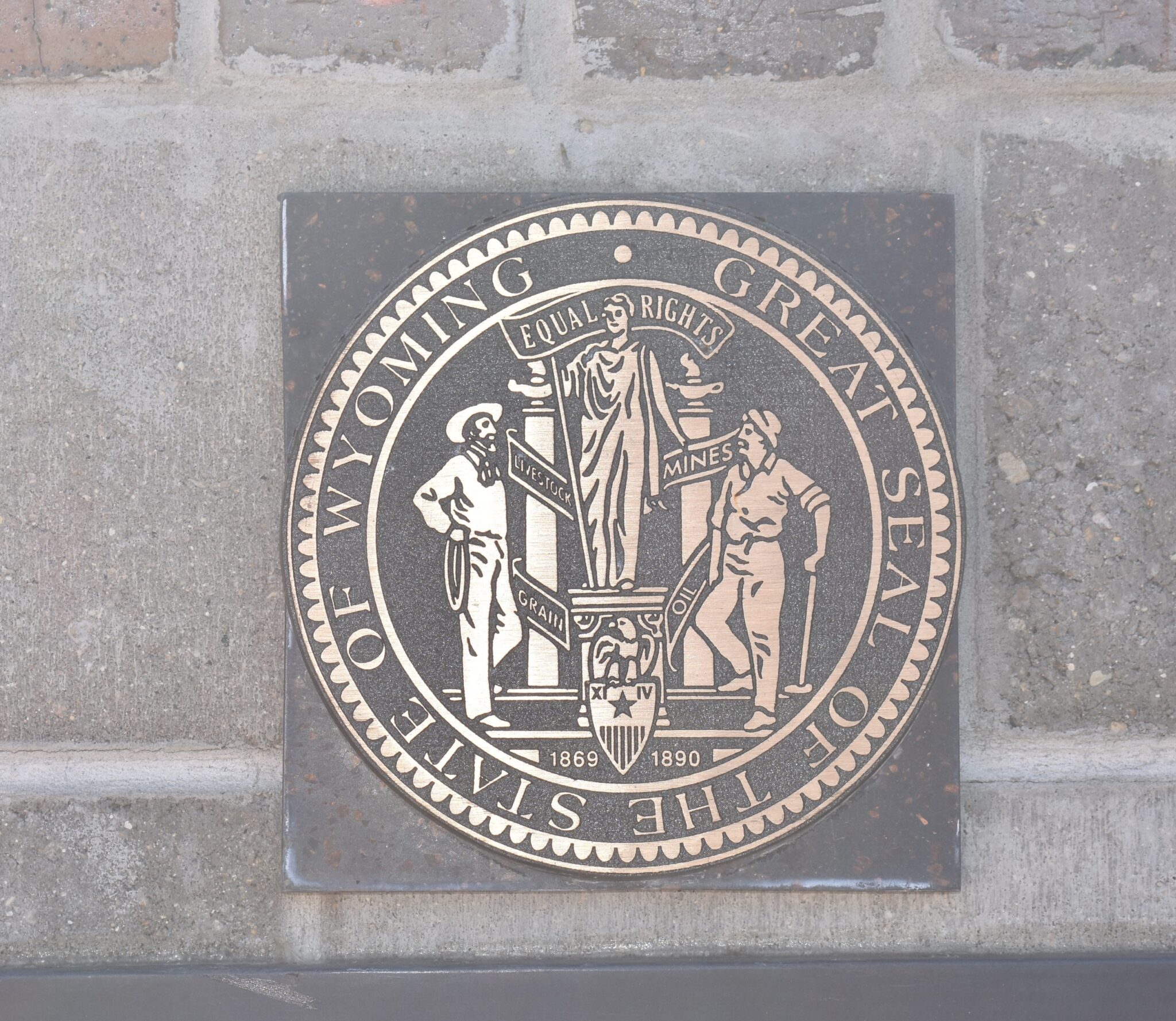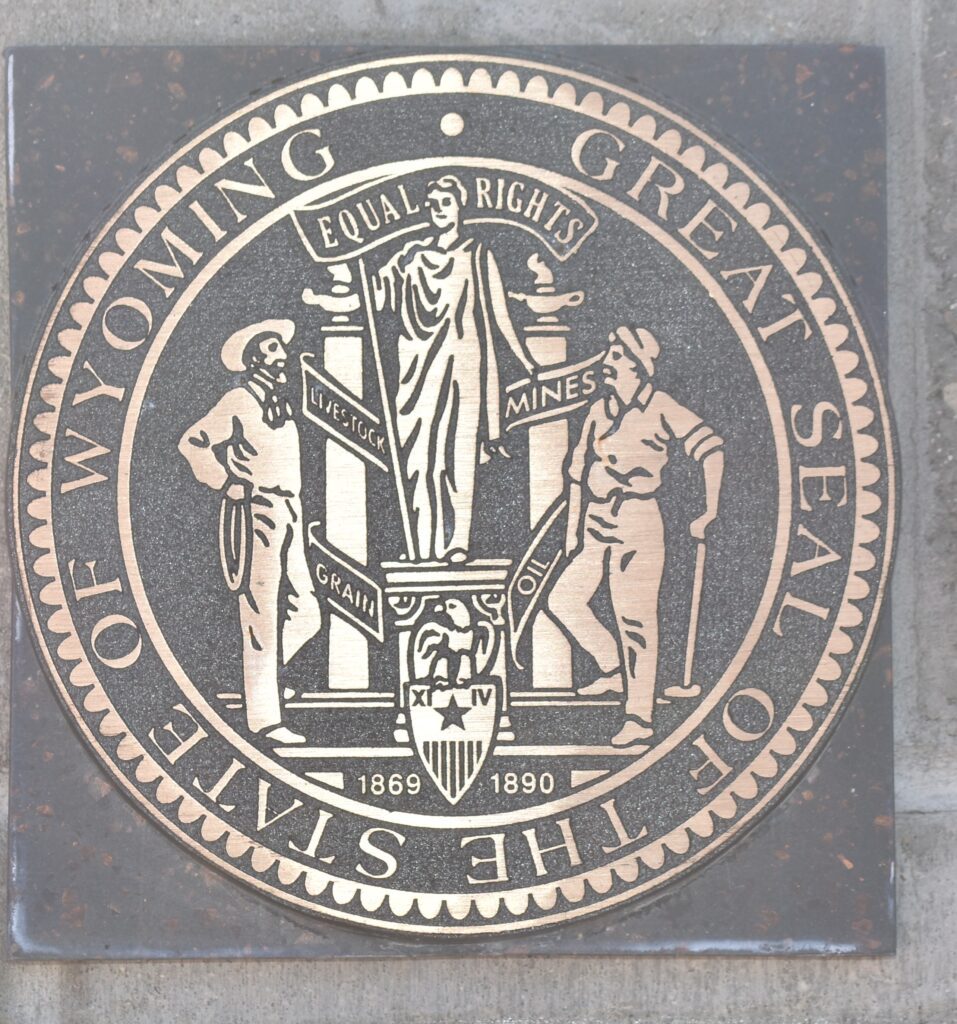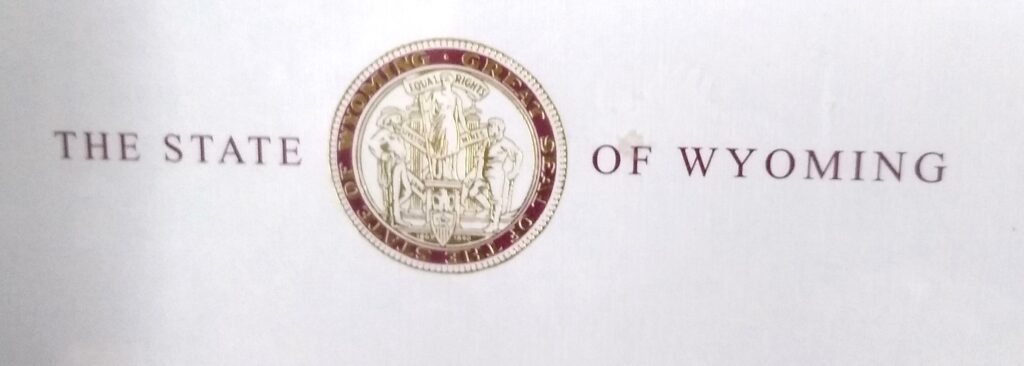News
Wyoming’s state seal

This month marks the 130th Anniversary of the Great Seal of the State of Wyoming.
The United States of America and every one of the fifty states has an official seal. This is used to authenticate documents of high importance. They are used on the letterheads of the states and the U.S. Government.

It is usually held by the secretary of state, who is named the keeper of the state seal and used by the president and the state governors. It can also be used on various sites, such as veteran’s memorials.
Here is how the state seal was adopted by the second Wyoming legislature of 1893, and revised in 1921.
The Newcastle News-Journal, on June 28, 1893, describes the seal. The State Seal – A Description Of the New Impression Just Received. The new great seal of the state of Wyoming has been received at the office of the secretary of state. In comparison with the seals of other states the Wyoming seal is a beauty. The Sun says that the workmanship is very fine, and an impression shows up every part with great clearness. The seal has been described many times before but now it is on hand a brief statement of what it is may not be out of place.
The seal contains three figures. A figure of a woman standing on a pedestal is the upper center and she holds a staff from which runs a streamer bearing the words, “Equal Rights.” On the right side is the figure of a cowboy on the left a miner. A streamer bears the words “Livestock” “Grain” “Mines and “Oil.”
Around the inner picture are the words: ‘The Great Seal of the State of Wyoming.” The whole forms a beautiful and an appropriate design. The seal was designed by Edward A. Stewardson who was employed by Amos W. Barber, while he was governor, at his own expense. The model, in plaster, was four feet in circumference, and was approved by the last legislature. It was then sent to the mint at Philadelphia.—Republican.

However, Western humor being what it is, the seal did have one major problem before it could be accepted by the governor. In the Cheyenne Daily Sun March 14 1891 – Wyoming’s State Seal. The New York Sun of March 9 devoted a column of its space on the editorial page to “Wyoming’s Trouble About a Seal.” The troubles which the people of New York encountered and overcame in securing for themselves and their posterity a seal, are now experienced by the people of New York’s youngest sister, Wyoming.
But it is to be regretted that those in charge of the affairs of that newcomer into the union instead of approaching their task in a solemn and sedate spirit have permitted some humorously disposed persons to interfere with their patriotic plans. Just who the offenders are has not yet been discovered, but they have been able to do more damage to the reputation of Wyoming in a few days than did all the seal makers of Albany’ to this state thirty years.
The design originally selected by the Wyoming legislature consisted of a landscape made up of mines and ranches. Over this was a platform inscribed “Equality of Rights.” Upon the platform stood the clothed figure of a beautiful western woman, from whose plump, shapely, and well rounded arms broken chains were falling, symbolical of the enfranchisement of women in the new state, the constitution of which provides that the right to vote or to hold office “shall not be abridged on account of sex.” Both male and female citizens (declares that document)shall enjoy legally all civil, political and religious rights and privileges. Unfortunately for the carrying out of this idea, so strongly suggestive of the chivalrous notions of the legislature, some one, either alone or with the aid of confederates, changed the plan by casting the seal with the female figure upon it un-draped. representing very indecorously the model in the “Clemenceau Case.”
Her beautiful draperies were gone, as if they had been caught in a cyclone. The officers of the state did not notice the change until a number of most important legal papers, the very title deeds to state existence, were stamped with the highly objectionable seal. Thus, notwithstanding the declarations of its constitution the new state starts, so to speak, under false pretenses, so far as the female population is concerned; for while, on the one hand, women enjoy the right of suffrage, they are, in their collective capacity, most shamefully insulted upon every legal document upon which this seal of the state is affixed. At last accounts the legislators of Wyoming were “protesting vigorously” against the new seal, and the aid of the lawyers of Wyoming was invoked to hew out if possible a means of escape from the condition which confronts all the notaries of the commonwealth. But the objection able seal still endures; it has been approved by the governor, and the legislature has adjourned, we under stand, sine die, without making any arrangement for abolishing it.

Grave as is the crisis, mean and contemptible as was the act of the man or the men who stand opposed to equal political rights for both sexes, the situation in Wyoming may not be so bad as it seems. Condemnation of the offenders may be tempered with some lenity when the facts are considered and understood. For it may have been that the objection of those who changed the seal was not to the wearing of clothes by, the young lady who embodied the notion of political enfranchisement, but to the kind of clothes she wore. The garments may have been in the latest Laramie City style. The designer may have yearned to see her in more attractive and better fitting apparel. Her un-draped the figure and forget or neglected to put on new clothes. Perhaps he was, carried away by his artistic fervor an excellent thing in its way, and perhaps complimentary to the lady in this particular instance, yet wholly out of place in the performance of the public duties which, as it certain authority has told us, are merely public trusts.
And this from Bill Barlow’s Budget, March 18, 1891 – According to the state press, an awful accident has happened the beauteous maiden who occupies a conspicuous position in the design adopted as the state seal by the late frolicsome body composing the first Wyoming legislature. Somebody has stolen her clothes.
The Buffalo Echo, in discussing the matter, says: The theft occurred between the departure of the document from the legislative halls and its receipt by the executive. The well-designed and laboriously- executed sketch went forth with the female appropriately draped after the mode usually affected by the conventional representative of Justice. The seal approved by the governor bore the counterfeit presentment of a nymph supposedly ready for a bath.
Governor Barber either was not informed as to to the appearance of the original design or lacks the real gift of a connoisseur of art, for the substitution pasted through his hands without a hitch, and the warm weather seal became the official property of the state. The Echo man doesn’t know our governor, neither does he know the facts regarding the executive’s approval of the bill. If the Cheyenne press reporter will examine that bill, that bill, they will will find that the governor wrote thereon: Approved, except as to the nudity of the women.
And a short piece from the The Cheyenne Daily Sun, March 7, 1891, To the purloiner: Return the gown stolen from the state seal figure and get rewarded. No questions asked.
But the seal was redone, and the woman was re-clothed. This month the state seal is 130 years old, and represents Wyoming very well.


Ira Roadifer
February 18, 2023 at 7:33 pm
Thank you. Enjoyed the making and designing of our great seal of Wyoming.